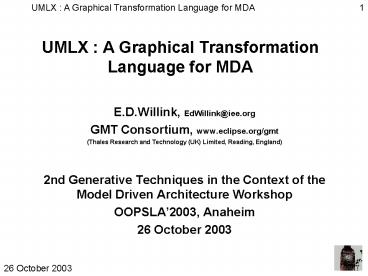UMLX : A Graphical Transformation Language for MDA - PowerPoint PPT Presentation
Title:
UMLX : A Graphical Transformation Language for MDA
Description:
Platform Independent Model. specification of what needs to be done ... Platform (Description) Model. physical, virtual, intellectual resources ... – PowerPoint PPT presentation
Number of Views:47
Avg rating:3.0/5.0
Title: UMLX : A Graphical Transformation Language for MDA
1
UMLX A Graphical Transformation Language for MDA
- E.D.Willink, EdWillink_at_iee.org
- GMT Consortium, www.eclipse.org/gmt
- (Thales Research and Technology (UK) Limited,
Reading, England) - 2nd Generative Techniques in the Context of the
Model Driven Architecture Workshop - OOPSLA2003, Anaheim
- 26 October 2003
2
Overview
- UML and QVT perspective
- Use UMLX in less obvious ways
- workshop paper shows use as a programming
language - Not UMLX Concrete Graphical Syntax
- see the workshop paper
- Transformation as a Composable Component
- Summary
3
Transformation in Program Context
- Start state comprises the input model(s)
- End state comprises the output model(s)
- For QVT
- Transformation hierarchy is the full program
- More generally
- Transformation is a more powerful form of state
transition
4
Transformation Syntaxes
- 1 Abstract Transformation Syntax (QVT)
- 1 Concrete Textual Syntax
- 1 Concrete Graphical Syntax
- Transformations
- to QVT (extract information content)
- between formats via XMI or XMID
5
MDA Models
- Platform Independent Model
- specification of what needs to be done
- too abstract for implementation
- Platform (Description) Model
- physical, virtual, intellectual
resourcesavailable to implement solution - Platform Specific Model
- a particular implementation
- Mark Model
- PIM PDM specific configuration
6
MDA Meta-Models
- Every Model is an instance of some Meta-Model
- traditionally the meta-model has been undefined
but implicit - with MDA we model it
7
Transform as a Model
- Transform may also be a model
- traditionally just Java code
- but even Java code is an instance of the Java
meta-model - Closed perspective - frozen executable
- Open perspective - generic engine, re-usable
model
8
Transform between Meta-Models
- Every model instantiates a meta-model
- Transformation meta-model reuses input/output
meta-model - UMLX extends UML for transformations
9
Transformation
- From LHS
- read-only
- shared
- To RHS
- write-only
- shared
- non-conflicting
- In-place if LHS and RHS are same model instance
- Define LHS meta-model
- Define RHS meta-model
- Define transformations between meta-model
instances - (and pivot models if complex)
10
Match order
- Select search order - a1,a2, b1,b2,b3,
c1,c2, d, e, f, g 'loop hoisting'
11
Schema driven matching
- Branch and bound search
- Advance one node/free variable per level
- pick narrowest relationship to advance to next
node - composition gt association
- forward gt backward
- unity multiplicity gt multiple
- validate advance
- type
- back relationships
- constraints
- nested transformations
- Smarter heuristics can lookahead
12
Composition
- Re-usable black boxes
- Encapsulation
- internal data
- internal behaviour
- Defined Interface
- external data
- external behaviour
- Meta-Models define what the external data
comprises - Ports define where the external data flows
13
Scheduling/Synchronisation
- Data flow defines when transformation occurs
- when the input models exist, then output gets
created - Evolution identities (and ordered sets) define
how - multiple concurrent match results are combined
- multiple concurrent transform results are
combined - Shared, read-only LHS
- Shared, non-conflicting write-only RHS
- Declarative, with causal constraints
14
Re-usability
- The UML to RDBMS example
- http//dev.eclipse.org/viewcvs/indextech.cgi/gmt-h
ome/doc/umlx/M4M03.pdf?revHEAD - 11 transforms in UMLX
- multiple transforms/steps/rules/helpers in other
approaches - UMLX transform unifies concepts
- Rule/Step is a transform with inputs/outputs
bound - steps may be factored out as (sub-)transformations
- Helper is a transform with inputs bound
- predicates may be factored out as
(sub-)transformations - Graphics scalability problems soluble
- factoring out sub-transformations with good clear
names - use of embedded OCL
15
UMLX Support
- UMLX editor configured within GME
- by defining a UMLX editing meta-model
- UMLX compiler designed in UMLX
- over 200 diagrams so far
- UMLX execution engine designed in UMLX
- over 100 diagrams so far
- Bootstrap by manual transliteration to NiceXSL
- human-friendly form of XSLT
- Prototype generates XSLT code
- currently for concurrent and sequential
transforms on classes - gt Fast, configurable, custom compiler-compiler
16
Summary
- UMLX is a natural extension of UML
- opportunities for more elaborate/useful syntaxes
- UMLX exhibits good composition properties
- declarative transform sequencing
- can degenerate to imperative
- declarative transform concurrency
- can be ordered
- arbitrary OCL at innermost level
- influence the QVT abstract syntax
- UMLX tools progressing































